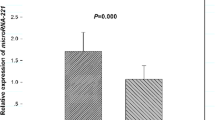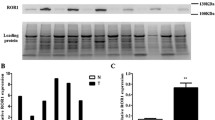Abstract
Frat1 has been reported to be overexpressed in several human malignant tumors, including esophageal squamous, cervical, breast, and ovarian carcinoma, but the role of Frat1 in lung cancer is unknown. Our purpose is to investigate the expression of Frat1 and its correlation with clinicopathologic features and prognosis in lung cancer patients. Immunohistochemistry was performed on 137 cases of non-small cell lung cancer (NSCLC), including 78 cases with clinical follow-up, and Western blot and reverse transcription-polymerase chain reaction (RT-PCR) assays were performed to detect the protein and mRNA expression levels in 30 NSCLC and autologous matched normal tissues. In addition, lung cancer cell line A549 was transfected with Frat1-siRNA plasmids and Matrigel invasive assay was carried out to study the function of Frat1 in cancer cell invasiveness. The results showed that Frat1 was expressed in 85 (62.04%) cases of NSCLC by immunohistochemistry, while all 30 specimens of normal lung tissues were negative. Western blot and RT-PCR results for Frat1 mRNA were in agreement with immunohistochemical findings. Of interest, the expression of Frat1 was strongly correlated with tumor differentiation, TNM stage, and lymph node metastasis (P < 0.05). The Kaplan–Meier survival analysis demonstrated that the cases with Frat1 expression had significantly shorter survival than those without Frat1 (P < 0.001). In addition, down-regulation of Frat1 expression reduced the invasive ability in the A549 cell line, further supporting the idea that Frat1 may play a crucial role in carcinogenesis, tumor invasiveness and dissemination in human lung cancer.






Similar content being viewed by others
Abbreviations
- Frat1:
-
Frequently rearranged in advanced T-cell lymphomas 1
- NSCLC:
-
Non-small cell lung cancer
- SCC:
-
Squamous cell carcinoma
- PBS:
-
Phosphate-buffered saline
- PVDF:
-
Polyvinylidene fluoride
- GBP:
-
GSK3-binding protein
- Frz:
-
Frizzled protein
- Dvl:
-
Dishevelled protein
References
Culbert AA, Brown MJ, Frame S (2001) GSK-3inhibition by adenoviral Frat1 over-expression is neuroprotective and induces Tau dephosphorylation and beta-Catenin stabilisation without elevation of glycogensynthase activity. FEBS Lett 507(3):288–294
Hagen T, Cross DA, Culbert AA (2006) Frat1, a substrate-specific regulator of glycogen synthase kinase-3 activity, is a cellular substrate of protein kinase A. J Biol Chem 281(46):35021–35029
Wang Y, Liu S, Zhu H (2008) Frat1 over-expression leads to aberrant activation of beta-Catenin/TCF pathway in esophageal squamous cell carcinoma. Int J Cancer 123(3):561–568
Wang Y, Hewitt SM, Liu S (2006) Tissue microarray analysis of human Frat1 expression and its correlation with the subcellular localisation of beta-Catenin in ovarian tumours. Br J Cancer 13;94(5):686–691
Guo G, Mao X, Wang P, Liu B (2010) The expression profile of Frat1 in human gliomas. Brain Res 1320:152–158
Guo G, Liu B, Zhong C (2009) Frat1 expression and its correlation with pathologic grade, proliferation, and apoptosis in human astrocytomas. Med Oncol 2009 Dec 30 [Epub ahead of print]
Jonkers J, Korswagen HC, Acton D (1997) Activation of a novel proto-oncogene, Frat1, contributes to progression of mouse T-cell lymphomas. EMBO J 16(3):441–450
Jonkers J, Weening JJ, van der Valk M (1999) Overexpressionof Frat1 in transgenic mice leads to glomerulosclerosis and nephrotic syndrome, and provides direct evidence for the involvement of Frat1 in lymphomaprogression. Oncogene 18(44):5982–5990
Freemantle SJ, Portland HB, Ewings K (2002) Characterization and tissue-specific expression of human GSK-3-binding proteins Frat1 and FRAT2. Gene 291(1–2):17–27
Saitoh T, Katoh M (2001) Frat1 and FRAT2, clustered in human chromosome 10q24.1 region, are up-regulated in gastric cancer. Int J Oncol 19:311–315
Salic A, Lee E, Mayer L (2000) Control of beta-Catenin stability: reconstitution of the cytoplasmic steps of the wnt pathway in Xenopus egg extracts. Mol Cell 5(3):523–532
Franca-Koh J, Yeo M, Fraser E (2002) The regulation of glycogen synthase kinase-3 nuclear export by Frat/GBP. J Biol Chem 277(46):43844–43848
Hino S, Michiue T, Asashima M (2003) Casein kinase I epsilon enhances the binding of Dvl-1 to Frat-1 and is essential for Wnt-3a-induced accumulation of beta-Catenin. J Biol Chem 278(16):14066–14073
Webster MT, Rozycka M, Sara E (2000) Sequence variants of the axin gene in breast, colon, and other cancers: an analysis of mutations that interfere with GSK3 binding. Genes Chromosomes Cancer 28(4):443–453
Dajani R, Fraser E, Roe SM (2003) Structural basis for recruitment of glycogen synthase kinase 3beta to the axin-APC scaffold complex. EMBO J 22:494–501
Hay E, Faucheu C, Suc-Royer I (2005) Interaction between LRP5 and Frat1 mediates the activation of the Wnt canonical pathway. J Biol Chem 280(14):13616–13623
Ruiz S, Segrelles C, Santos M (2004) Functional link between retinoblastoma family of proteins and the Wnt signaling pathway in mouse epidermis. Dev Dyn 230(3):410–418
Fraser E, Young N, Dajani R (2002) Identification of the Axin and Frat binding region of glycogen synthase kinase-3. J Biol Chem 277(3):2176–2185, Epub 2001 Nov 13
Okino K, Nagai H, Hatta M (2003) Up-regulation and overproduction of DVL-1, the human counterpart of the Drosophila dishevelled gene, in cervical squamous cell carcinoma. Oncol Rep 10:1219–1223
Li L, Yuan H, Weaver CD (1999) Axin and Frat1 interact with dvl and GSK, bridging Dvl to GSK in Wnt-mediated regulation of LEF-1. EMBO J 18(15):4233–4240
Clements WM, Wang J, Sarnaik A (2002) beta-Catenin mutation is a frequent cause of Wnt pathway activation in gastric cancer. Cancer Res 62:3503–3506
Lim SC, Lee MS (2002) Significance of E-cadherin/beta-Catenin complex and cyclin D1 in breast cancer. Oncol Rep 9:915–928
Van Amerongen R, Berns A (2005) Re-evaluating the role of Frat in Wnt-signal transduction. Cell Cycle 4(8):1065–1072
Van Amerongen R, Nawijn MC, Lambooij JP (2010) Frat oncoproteins act at the crossroad of canonical and noncanonical Wnt-signaling pathways. Oncogene 29(1):93–104
Van Amerongen R, Nawijn M, Franca-Koh J (2005) Frat is dispensable for canonical Wnt signaling in mammals. Genes Dev 19(4):425–430
Acknowledgements
The authors thank Dr. Maggie Stoecker and Dr. Endi Wang, Department of Pathology, Duke University Medical Center, for their critical review and extensive editing of this revised manuscript. The study was supported by National Natural Scientific Foundation (grants 30870977 and 81071905 to Enhua Wang).
Conflict of interest
The authors declare that they have no competing financial interests. No part of this article has been published or submitted elsewhere, and there are no financial or other relationships that might lead to a conflict of interest. The manuscript has been read and approved by all authors.
Author information
Authors and Affiliations
Corresponding author
Rights and permissions
About this article
Cite this article
Zhang, Y., Yu, JH., Lin, XY. et al. Overexpression of Frat1 correlates with malignant phenotype and advanced stage in human non-small cell lung cancer. Virchows Arch 459, 255–263 (2011). https://doi.org/10.1007/s00428-011-1135-5
Received:
Revised:
Accepted:
Published:
Issue Date:
DOI: https://doi.org/10.1007/s00428-011-1135-5




